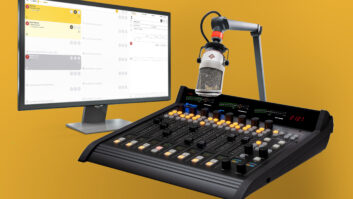The author is with Clyne Media, a PAMA member company and PR/marketing firm.
What defines a broadcast microphone?
It could be argued that any microphone used for a broadcast purpose fits the bill, but that fails to focus in on the unique needs of broadcasters and the highly sensitive, market-driven efforts that manufacturers are undertaking to deliver what today’s broadcasters need.
In a recent survey conducted by the Professional Audio Manufacturers Alliance (PAMA) of member companies, representatives from major professional audio brands — Shure, Audio-Technica, Harman and Sennheiser — were asked to share their opinions on broadcast mics.
The resulting information reveals certain common threads among these industry leaders: namely, that a broadcast mic should be highly tailored to the end user and their application, with the manufacturer thinking several steps ahead to make the microphone a highly durable tool able to withstand the rigors of everyday use (whether in studio or in the field).
And just as crucially, a broadcast mic should serve as a successful, user-friendly, often nearly transparent or entirely invisible tool that performs as intended in a variety of settings.
Blurry lines
A full accounting of what is considered a broadcast microphone is harder than ever to nail down.
An on-air radio mic, a camera-mounted or boom-mounted shotgun mic, a radio or TV reporter’s handheld ENG interview mic, on-air talent lavalier — these are all very different microphones designed to serve different purposes, yet they are undeniably broadcast mics.

But what about microphones geared more toward the growing content creation and podcasting market, such as hypercardioid USB mics? (Not to mention tools, like boundary microphones, used for videoconferencing, which is part of basically everyone’s reality post-COVID.) Or what about a multi-channel microphone capable of capturing an immersive multi-channel soundfield at a sporting event for surround-sound production?
The line between consumer audio, broadcast audio and specialized pro audio starts to get blurry.
It is worth having the discussion, though. What characteristics, features and special considerations make a microphone more suited for broadcast purposes over an otherwise comparable product? What market demands are manufacturers responding to when they engineer a broadcast solution?
Some microphones have the reputation as often somewhat fragile gadgets, but well-engineered broadcast microphones should be rugged and durable.

John Born, associate director of product management at PAMA member company Shure, remarks in his survey response, “Everyday use can be rough on technology, and the realities of broadcast audio really can put a mic through the wringer. A broadcast mic should offer the ability to deliver excellent audio quality despite different factors such as moisture, heat, rain, humidity, air pressure differences, ingress protection, storage, transportation, etc.
“And budget-wise, we know that broadcasters measure time in decades rather than years, so products must last. And in instances where components do wear out over time, there is an opportunity to think in terms of modular, replaceable parts to lengthen the investment.”
Some of the most technically skilled and knowledgeable audio professionals in the industry today work in broadcast; however, for every white-paper-submitting AES contributor, there are several who have more of a background in electronic journalism than audio engineering. These pros need their microphones to be rugged and “just work” come crunch time, with minimal troubleshooting or extra technical wizardry required.
Gary Boss, PAMA board member and Audio-Technica U.S. marketing director, remarks, “Many of these mics may be used by non-audio engineers, so ease of use is high on the list of design considerations. Vocal intelligibility is key, so for we often concentrate on a flattering vocal curve without sacrificing high-end articulation for these products. Furthermore, we know that condenser mics like shotguns will often be run with pretty high gain, so low self-noise is an important spec.”

Chris Hansen, PAMA board member and director of recording at Harman International, stresses the versatility of a successful broadcast product.
“Broadcast audio has its own set of challenges as technologies and formats continue to evolve. Just a few years ago, USB microphones were thought of as low-fi audio devices. Now, with the growth of podcasting, gaming and streaming, many individuals who once considered themselves hobbyists now see themselves as professionals — and they expect professional results from their equipment. In the post-pandemic environment, the worlds of content creation, video conferencing and production have converged with broadcasting. There’s a lot of overlap.”
Thus, Hansen notes, some USB microphones are capable of 96 kHz hi-res audio output. That’s comparable to an analog XLR microphone with high-quality conversion from an external audio interface. Production playback for broadcast audio can occur on desktop studio monitors, headphone or sometimes on Bluetooth-equipped headphones.
“These devices can be found within the same production ecosystem. Manufacturers have to be open to that reality. Products must be cross-platform and format agnostic.”
Dennis Stegemerten, solution architect at PAMA member Sennheiser, stresses that besides audio quality and robustness, the look of the microphone can also play an important role.

“A broadcast mic should look professional on a person; on camera, it should be lightweight. A lavalier mic, on the other hand, should basically be invisible while still delivering great sound. If a manufacturer can nail all these features, they will have a winner on their hands.”
So an answer to the question of “what makes a broadcast mic” is perhaps more mercurial than ever, but the manufacturers responding to market trends know that durability, ease of use (even for non-engineers), a high level of versatility and a consideration for visual aesthetics are several of the important features that factor into the success of a microphone created for the broadcast market.
The Professional Audio Manufacturers Alliance is “the collective voice and forum for the leading manufacturers of professional audio products and the people who use them.” Learn more at www.pamalliance.org.












